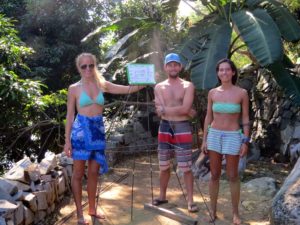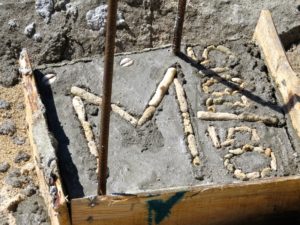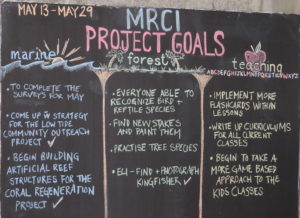When we first arrived on camp, we were told that an artificial reef is something that Liz, the Director of Operations, has been wanting to do. The last week of camp, the artificial reef was finally put on the goal board as a “design and outline brainstorm.” Nick and I immediately grabbed hold of this idea, and within a few days not only made an outline of the reef and how it would work, but we also designed, built AND planted the reef. It’s definitely been a highlight of our camp experience.

First Construction Crew
Nick and I have done quite a bit of research on our own about artificial reefs, and brought our ideas to the table when we broke out in groups to discuss future projects. Our fellow volunteers also had some good ideas, and by the end of the brainstorm, we had four designs for artificial reefs to choose from. Rebar came in from Hellville that day, and the next morning bright and early, Nick, Mafalda, and I constructed (most likely) the first artificial reef in Northwestern Madagascar.
It took another day to get the materials for our concrete anchor, and for it to set, so two days after our pyramid was cut and bended into shape, we constructed it. James,the marine science officer at MRCI, Nick and I were the divers with Mafalda, Alex, and Joaquin as snorkel surface support. It took all of us, with the help of some inflated lift bags to float the concrete anchor, and pyramid structure out over the reef and into the sand. Our snorkel support also managed to get some awesome footage of us building the reef underwater. Way awesome.

Custom Made Concrete Anchors
We had put an ‘M’ made out of dead washed up coral rubble on our concrete anchor. We told everyone it was for ‘Madagascar’ but we meant it for Muzia, and Mafalda claimed it as well. Unfortunately, we had to bury the anchor; it stood too tall in order to properly do it’s job. It took us just under fifty minutes to build the reef, ten of which were spent trying to find the site carrying equipment in current. We were elated when the pyramid stood at the end of the dive.
Two days later we went out with Liz and Kyle and added some rocks underneath the pyramid for a harder structure for the coral to grow on, and tied some coral onto the squares. At the end of another fifty minute dive, the structure went from a random pyramid in the middle of a sandy oasis to looking like a proper reef. We’ve asked to be kept updated of progress and coral growth; it’s so exciting to be a part of this project.



Recent Comments